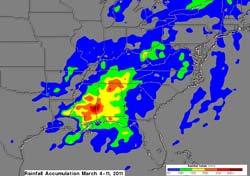TRMM maps flooding along US East Coast from massive storm

Although the heaviest rainfall last week was in the southern United States, flooding was reported in states from Louisiana to northern New York. A rainfall analysis was created made by merging precipitation data from multiple satellites.
This Multisatellite Precipitation Analysis (TMPA) analysis used data that were calibrated with TRMM precipitation data. These data are calculated and stored at NASA Goddard and are available within a few hours after being received by satellites.
The analysis indicated that the greatest total rainfall for the past week was over 300 mm (~11 inches) and was located over Alabama and Mississippi. Some of the extremely heavy rainfall in this area was associated with tornado spawning thunderstorms (see: http://trmm.gsfc.nasa.gov/publications_dir/tornadoes_7-10may11.html).
Much of the eastern United States was affected by rainfall totals of over 50 mm (~2 inches). As the weather system moved east, some of the most impressive rainfall totals in the Mid-Atlantic fell between Baltimore, Md. and Charlottesville, Va. On Thursday, March 10, Baltimore set a new daily rainfall record measuring 2.61 inches according to the National Weather Service. Charlottesville received 2.33 inches of rainfall from the system. To the west, Martinsburg, West Virginia also reported a daily record rainfall total of 1.26 inches. Many areas had flooding with totals that were less than the extreme amounts shown on the rainfall analysis.
Hal Pierce/Rob Gutro
NASA's Goddard Space Flight Center
Media Contact
All latest news from the category: Earth Sciences
Earth Sciences (also referred to as Geosciences), which deals with basic issues surrounding our planet, plays a vital role in the area of energy and raw materials supply.
Earth Sciences comprises subjects such as geology, geography, geological informatics, paleontology, mineralogy, petrography, crystallography, geophysics, geodesy, glaciology, cartography, photogrammetry, meteorology and seismology, early-warning systems, earthquake research and polar research.
Newest articles

Trotting robots reveal emergence of animal gait transitions
A four-legged robot trained with machine learning by EPFL researchers has learned to avoid falls by spontaneously switching between walking, trotting, and pronking – a milestone for roboticists as well…

Innovation promises to prevent power pole-top fires
Engineers in Australia have found a new way to make power-pole insulators resistant to fire and electrical sparking, promising to prevent dangerous pole-top fires and reduce blackouts. Pole-top fires pose…

Possible alternative to antibiotics produced by bacteria
Antibacterial substance from staphylococci discovered with new mechanism of action against natural competitors. Many bacteria produce substances to gain an advantage over competitors in their highly competitive natural environment. Researchers…





















